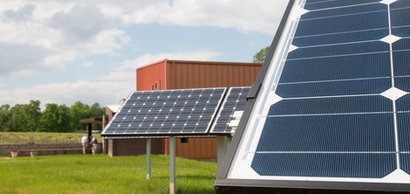
The report End-of-Life Management: Solar Photovoltaic Panels by IRENA, in association with the International Energy Agency’s Photovoltaic Power Systems Programme (IEA-PVPS), is the first ever projection of PV panel waste volumes to 2050, highlighting that recycling or repurposing solar PV panels at the end of their lifetime can unlock a large stock of raw materials and other valuable components. It estimates that PV panel waste, consisting mostly of glass, could total 78 million tonnes globally by 2050. This in turn could exceed $15 million injected back into the economy by 2050 in terms of the value of the recovered material.
This material could potentially be used to produce 2 billion new panels or be sold into global commodity markets, thereby increasing the security of future solar PV supply or other products dependent on raw materials.
The report also suggests that addressing growing solar PV waste, and spurring the establishment of an industry to handle it, would require the adoption of effective, PV-specific waste regulation and the expansion of existing waste management infrastructure to include end-of-life treatment of PV panels as well as the promotion of ongoing innovation in panel waste management.
“Global installedPV capacity reached 222 GW at the end of 2015 and is expected to further rise to 4,500 GW by 2050” said IRENA Director-General Adnan Z. Amin. “With this tremendous capacity growth will come an increase in waste associated with the sector. This brings about new business opportunities to ‘close the loop’ for solar PV panels at the end of their lifetime. To seize these opportunities, however, preparations for the surge in end-of-life material should begin now. With the right policies and enabling frameworks in place, new industries that recycle and repurpose old solar PV panels will drive considerable economic value creation and will be an important element in the world’s transition to a sustainable energy future.”
Stefan Nowak, Chairman of IEA-PVPS, added that experience with electronic waste tells us that developing technological and regulatory systems for efficient, effective and affordable end-of-life management requires long lead times and that responsible life-cycle management is an imperative for all PV technologies. The socio-economic and environmental benefits which can potentially be unlocked through end-of-life processes and policies for this waste stream in the future should be seen as an opportunity today to start extending the photovoltaic value chain. Mr Nowak believes that the report can be used by public and private sector institutions to anchor the necessary investments in technology and policy research and development and supporting analyses to unlock the significant recoverable value in end-of-life panels.
In most countries, PV panels fall under the classification of “general waste” but the European Union (EU) was the first to adopt PV-specific waste regulations, which include PV-specific collection, recovery, and recycling targets. EU’s directive requires all panel producers that supply PV panels to the EU market (wherever they may be based) to finance the costs of collecting and recycling end-of-life PV panels put on the market in Europe.
End-of-Life Management: Solar Photovoltaic Panels, is the second of several solar-focused publications IRENA is releasing this summer. Last week, IRENA released The Power to Change, which predicts average costs for electricity generated by solar and wind technologies could decrease by between 26 and 59 per cent by 2025. Later this week, IRENA will release Letting in the Light: How Solar Photovoltaics Will Revolutionize the Electricity System – which provides a comprehensive overview of solar PV across the globe and its prospects for the future.
For additional information:
International Renewable Energy Agency (IRENA)
International Energy Agency Photovoltaic Power Systems Programme (IEA-PVPS)

